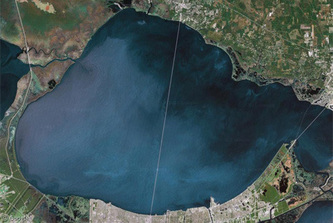General Statistics
Area: 181 square miles (2000)
Elevation: Ranges from 5 feet below sea level to 15 feet above; mean elevation, 5 feet above sea level
Average Temperatures: January, 51.3° F; July 81.9° F; annual average, 68.1° F
Average Annual Precipitation: 61.88 inches
Coordinates: 29.9728° N, 90.0590° W
Elevation: Ranges from 5 feet below sea level to 15 feet above; mean elevation, 5 feet above sea level
Average Temperatures: January, 51.3° F; July 81.9° F; annual average, 68.1° F
Average Annual Precipitation: 61.88 inches
Coordinates: 29.9728° N, 90.0590° W
The landmass of New Orleans is set at a mean elevation of 5 feet above sea level, many areas even drop below sea level. The average yearly temperature is 68.1 degrees Fahrenheit, while the average yearly precipitation is 61.8 inches, New Orleans experiences hot, humid summers, and mild winters. It is located 105 miles upriver from the Gulf of Mexico along the Mississippi River Delta and near Lake Pontchartrain and is characterized by its coastal and bay areas containing ridges and hollows. There are natural levees along the Mississippi River, making the region less vulnerable to hurricanes. However, the region is now showing signs of subsidence due to human interference. The effects of erosion and the loss of wetland have resulted in an unstable delta basement.
New Orleans is in a partly peninsular area with waterfront stretching around three different sides of it. The heart of the city spreads around a curve of the Mississippi River which gives it the nickname "Crescent City". Lake Pontchartrain, near the Mississippi River, connects to Lake Borgne, a broad opening to the Gulf of Mexico. Lakes, marshlands, and bayous extend from the city in all directions. Louisiana is divided into areas called parishes rather than counties; New Orleans itself occupies the entirety of Orleans Parish, while metropolitan New Orleans extends west into St. Charles, St. John, and St. James; south into Jefferson, Plaquemines, and St. Bernard Parishes, and north into St. Tammany Parish, and into other parishes as well.
New Orleans is in a partly peninsular area with waterfront stretching around three different sides of it. The heart of the city spreads around a curve of the Mississippi River which gives it the nickname "Crescent City". Lake Pontchartrain, near the Mississippi River, connects to Lake Borgne, a broad opening to the Gulf of Mexico. Lakes, marshlands, and bayous extend from the city in all directions. Louisiana is divided into areas called parishes rather than counties; New Orleans itself occupies the entirety of Orleans Parish, while metropolitan New Orleans extends west into St. Charles, St. John, and St. James; south into Jefferson, Plaquemines, and St. Bernard Parishes, and north into St. Tammany Parish, and into other parishes as well.
Elevation Diagrams
The sea elevation around New Orleans is above many parts of the city and the Mississippi River and Lake Pontchartrain have an even higher elevation. This diagram also shows that floodwalls have been built along the Mississippi River and the edge of the lake to control flooding during rainy seasons.
Videos!
Geography Photo Gallery
Advantages of the Geography of New Orleans
A man named Bienville founded the City of New Orleans at its present site because of its easy access to the Mississippi River through Lake Pontchartrain and Bayou St. John. The city was first owned by France. Shortly afterward, enslaved Africans arrived, adding to the mix of cultures in the Lake Pontchartrian Basin. Although New Orleans suffers from many disadvantages such as flooding, the geography still provides many advantages for the people that live and work in it. New Orleans’ geographic situation has been extraordinarily important historically, indispensable for America’s economic development. At the mouth of the Mississippi River system, it has been the commercial and strategic gateway to the continental interior. Political leaders of a growing nation recognized quite early that if New Orleans did not become part of the national territory, the economic development of the interior lands would be severely handicapped.
Disadvantages of the Geography of New Orleans
The lowest points in the city of New Orleans can drop to 5 feet below sea level or more. This poses a huge threat of flooding during hurricanes or rainy seasons where the Mississippi River or the levee system can be overwhelmed. Before human interference, the natural course of flooding and sediment deposition by the river created a natural barrier to help prevent flooding. Even with today's flood control systems, the low lying geography of New Orleans still faces the threat of flooding during hurricanes and/or storms. According to a study by the National Academy of Engineering and the National Research Council, levees and floodwalls
surrounding New Orleans, no matter how large or sturdy, cannot provide absolute protection against overtopping or failure in extreme events. Levees and
floodwalls should be viewed as a way to reduce risks from hurricanes and storm surges, not as measures that completely eliminate risk. Also, due to the surrounding waters and lakes of the city and its hot, humid climate, waterspouts (a tornado over a body of water) are a common and sometimes dangerous phenomenon near New Orleans.
surrounding New Orleans, no matter how large or sturdy, cannot provide absolute protection against overtopping or failure in extreme events. Levees and
floodwalls should be viewed as a way to reduce risks from hurricanes and storm surges, not as measures that completely eliminate risk. Also, due to the surrounding waters and lakes of the city and its hot, humid climate, waterspouts (a tornado over a body of water) are a common and sometimes dangerous phenomenon near New Orleans.
Links
Bibliography
http://geology.com/states/louisiana.shtml
http://www.city-data.com/us-cities/The-South/New-Orleans-Geography-and-Climate.html
http://en.wikipedia.org/wiki/New_Orleans
http://geography.about.com/od/unitedstatesofamerica/a/neworleansgeography.htm
http://www.buzzle.com/articles/geography-of-new-orleans.html
http://geography.howstuffworks.com/united-states/geography-of-new-orleans.htm
https://maps.google.com/maps?hl=en&q=new+orleans+geography&safe=active&ie=UTF-8
http://www.city-data.com/us-cities/The-South/New-Orleans-Geography-and-Climate.html
http://en.wikipedia.org/wiki/New_Orleans
http://geography.about.com/od/unitedstatesofamerica/a/neworleansgeography.htm
http://www.buzzle.com/articles/geography-of-new-orleans.html
http://geography.howstuffworks.com/united-states/geography-of-new-orleans.htm
https://maps.google.com/maps?hl=en&q=new+orleans+geography&safe=active&ie=UTF-8











